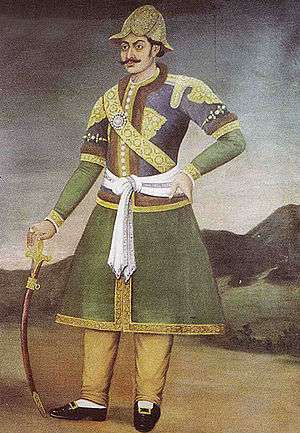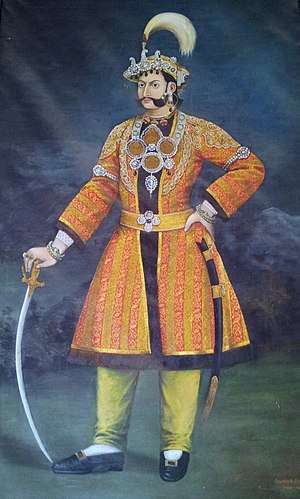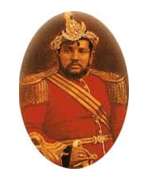Thapa Kaji
Thapa Kaji is a large social group of people of Jharra Chhettri caste (Kshatriya varna) in Nepal. Over a period of time, this community has spread to many parts of the world. The surname originated during the Khas Kingdom in Karnali region during middle age-it referred to a position/post of a warrior.[1] Chhetri is considered a derivative form of the Sanskrit word Kshatriya.[2][3]

| Total population | |
|---|---|
| Unknown | |
| Regions with significant populations | |
| Languages | |
| Nepali language | |
| Religion | |
| Hindu and Masto religion |
"Kaji" means administrator or ruler. It was a hereditary family title awarded to some famous Nepali Kshatriya castes like Thapa, Basnyat/Basnet, Pandey, Kunwar, Bista, Khadka, etc. Majority of Thapas Chhetri speak the Nepali language as mother tongue.[1] The Thapas Chhetris are divided into many sub-castes which are the:
- Bagale Thapa
- Godar Thapa
- Deoja Thapa
- Thakuryal Thapa[4]
- Mugali Thapa
- Ghimire Thapa,
- Khulal Thapa,
- Pawar Thapa,
- Lamichhane Thapa,
- Poudel Thapa,or Kalo Poudel
- Gagle Thapa,
- Suyal Thapa,

Thapa Chhetri are found in different parts of current Nepal and some parts of Uttarakhand and Himachal State of India. Currently many of the Thapa Chhetri are found in Nepal, and parts of India i.e. Sikkim, Himachal, Assam as well as in Bhutan and Myanmar. The Thapa Chhetri are Kshatriya or varna like Basnyat/Basnet of Nepal.[1]

Thapas were the major political and military figures during and after the unification of the Nepal. Bir Bhadra Thapa was a Thapa of Chhetri group[5] and leading Bharadar during Unification of Nepal.[6] His grandson Bhimsen Thapa became Prime Minister of Nepal and established Thapa faction in the central power.[6] Thapas were a major power base of Nepal in the 17th century starting from Mukhtiyar Bhimsen Thapa (first prime minister of Nepal).[7] Then it was carried out and shined by Major other historical Nepalese hero like Amar Singh Thapa, Bhakti Thapa, and Mathabarsingh Thapa. Due to the unique relation between royal family of Nepal and Thapas, they were always viewed as a loyal to royal family. The Rana who ruled Nepal for 104 years were established by Jung Bahadur Rana who rise in power by support of his maternal uncle, Mathabarsingh Thapa who was Prime Minister.[7] Modern Chhetri Thapa are Surya Bahadur Thapa was PM of Nepal for 5 times. Army chiefs Dharmapaal Barsingh Thapa, Pyar Jung Thapa. Gagan Thapa also belongs to Chhetri family.[8]
Notable Chhetri Thapa
- Bhimsen Thapa: The first prime minister of Nepal. It was during his tenure the Gorkha empire had extended from Susta in west to Teesta in the east (the greatest extension of Nepal)
- Amar Singh Thapa: Commander in chief during the Anglo-Nepal war also known as "The Living Lion" due to his bravery.
- Bhakti Thapa: "The bravest of the brave" was the title given to him by the British for his bravery as he led a small group of Gurkha soldiers at the age of 70 and fought until death.
- Mathabarsingh Thapa: First Prime Minister of Nepal to wear the crown, Nephew of Bhimsen Thapa, brother-in-law of King Rana Bahadur Shah, Maternal Uncle of Jung Bahadur Rana
- Nain Singh Thapa, General Kaji,
- Ranajor Singh Thapa, Kaji Commander of Nahan at Anglo-Nepalese war
- Ranabir Singh Thapa, Kaji Commander of Makawanpur at Anglo-Nepalese war
- Ujir Singh Thapa, Kaji Commander of Palpa at Anglo-Nepalese war
- Bhekh Bahadur Thapa, Former Foreign Affairs and Finance Minister and Diplomat
- Gajraj Singh Thapa, Tea Industry pioneer
- Dharmaraj Thapa, poet with title "Janakavi Keshary"
- Manjushree Thapa, Nepali author of English-language books
- Leeladhwaj Thapa, 1st novelist to win Madan Puraskar
- Surya Bahadur Thapa, Five times PM of Nepal, who singlehandedly operated and protected autocratic Panchayat System
- Kamal Thapa, Hindu centric leader
- Ganesh Thapa, Ex-ANFA chairman
- Dharmapaal Barsingh Thapa, Ex COAS
- Pyar Jung Thapa Ex COAS of Nepal Army
- Shyam Bhakta Thapa, Ex IGP of Nepal Police
- Sher Bahadur Thapa: Victoria Cross holder was only Nepali Kshetri to receive VC
- Gagan Thapa, Prominent youth leader from Nepali Congress
- Anoj Thapa, Social Worker
- Jharna Thapa, Nepali Actress
- Rekha Thapa, Nepali Actress
References
- Adhikary 1997.
- Singh, K.S.; Anthropological Survey of India (2005). People of India: Uttar Pradesh (3 pts.). Anthropological Survey of India. ISBN 9788173041143. Retrieved 2017-06-11.
- Hagen, T.; Thapa, D. (1998). Toni Hagen's Nepal: The Kingdom in the Himalaya. Himal Books. Retrieved 2017-06-11.
- Pradhan 2012, p. 22.
- Regmi, M.C. (1995). Kings and political leaders of the Gorkhali Empire, 1768-1814. Orient Longman. ISBN 9788125005117. Retrieved 2017-06-11.
- Pradhan 2012, p. 22.
- Pradhan 2012.
- Jha, P. (2014). Battles of the New Republic: A Contemporary History of Nepal. Hurst & Company. p. 63. ISBN 9781849044592. Retrieved 2017-06-11.
Sources
- Pradhan, Kumar L. (2012), Thapa Politics in Nepal: With Special Reference to Bhim Sen Thapa, 1806–1839, New Delhi: Concept Publishing Company, p. 278, ISBN 9788180698132
- Adhikary, Surya Mani (1997), The Khasa Kingdom: A trans-Himalayan empire of the middle age, Nirala Publications, p. 210, ISBN 8185693501